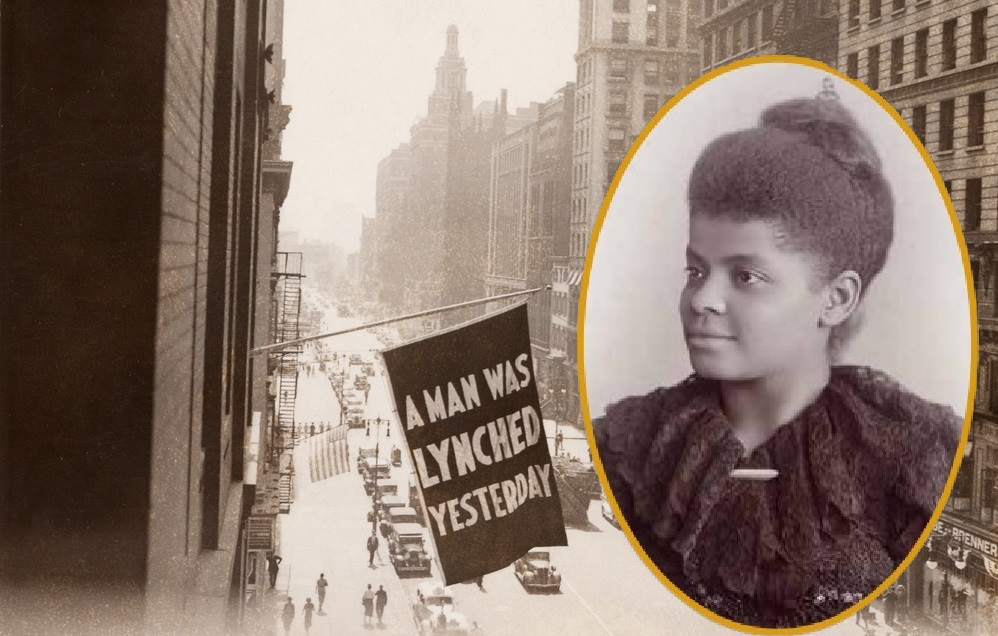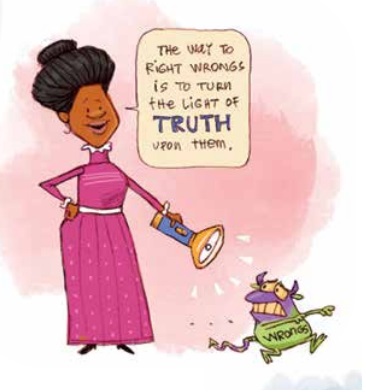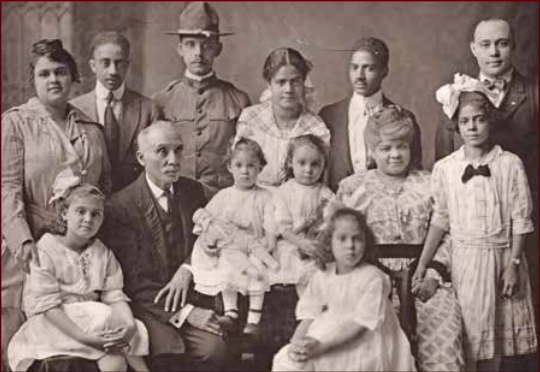Ida B. Wells-Barnett never gave up. A remarkable journalist, speaker, activist, and lifelong fighter for truth and justice, there’s a good chance you’ve heard her name before but don’t know the full details of her accomplishments. And some details of her extraordinary life may even surprise the most knowledgeable history students. The February issue of COBBLESTONE Magazine is all about Ida B. Wells-Barnett, and we’re sharing some of our favorite information that we learned from it.
On March 29, 2022, Congress passed the Emmett Till Antilynching Act, making lynching a federal hate crime. “Lynching” is defined as, “executing—usually by a mob—without a trial,” a brutal act that is often an act of racial violence. But many people do not know that Ida B. Wells-Barnett took some of the first steps in the long crusade against lynching over a century ago. The effects of her work are still playing out today. Here are more fascinating facts about Ida B. Wells.
Ida B. Wells was born into slavery- but her family was freed when she was only 6 months old.
The Emancipation Proclamation freed enslaved people in the Southern states in 1863. This changed everything for baby Ida B. Wells and her family, who lived in Holly Springs, TN. Her parents, who had both been enslaved and therefore not allowed to legally wed, got married at once. Her father opened a carpenter’s shop and became active in local politics.
Ida and her siblings all received an education at a school at Asbury Methodist Episcopal Church (now called Rust College), and even her mother attended the school to learn to read. Ida was an especially voracious reader, though she never actually graduated from school. According to Ida herself, it was due to her “rebelliousness.” That rebelliousness later served her well.
The 1978 Yellow Fever Epidemic changed Ida’s life forever
When she was only 16 years old, the deadly Yellow Fever struck her hometown of Holly Springs. While she was visiting her grandmother, Ida received word that both her parents and her baby brother had died of the disease. With five younger siblings to support– and a desire to keep the family together rather than handing her siblings off to other families– Ida became a school teacher. She had to lie about her age and pass a teaching exam to get the job, which she did, despite never graduating from school herself.
Ida B. Wells first made headlines because of a lawsuit
Although she would become a famous reporter, her first big news story was written about her, not by her. Every day, Ida took the train to and from her job, teaching in Woodstock, Tennessee. Due to unjust segregation policies, a conductor refused to take her first-class ticket. He instead forced he to sit in a second-class smoking car.
When he tried to physically move her, she fought back. The conductor and two other men dragged her out, tearing her coat and leaving her stranded behind. In response to this cruel treatment, Ida sued the railroad for discrimination. While she won the suit (and $500!), a second trial before the Tennessee Supreme Court reversed the decision. This profoundly disillusioned Ida, who until that point believed the law would be on her side and she’d receive justice.
Under the pen name “Iola,” she was hailed as “The Princess of the Press.”
While working as a teacher, Ida joined a lyceum– a club for intellectual and literary discussion– founded by Black teachers. Club meetings ended with readings from a newspaper called the Evening Star. When the editor of the paper moved away, Ida took over his duties. She was then invited to write articles for a local religious newspaper, Living Way. Despite having no training in journalism, readers enjoyed her clear, straightforward writing style. An article she wrote describing her lawsuit against the railroad soon helped her gain greater fame.
Newspapers around the country reprinted her article, and soon they wanted more! Before long, she was contributing to ten newspapers around the USA! She was even elected secretary of the National Press Association in 1889. Although few female reporters had much influence in the 19th century, Ida– or Iola, the name she wrote under– was called the “Princess of the Press.”
When a mob lynched a friend of hers, she found new purpose as a journalist
For Ida B. Wells, anti-lynching work was personal. A personal friend of hers, Thomas Moss, was a Black man who owned a successful grocery store. His main competitor in business was a white man who felt jealous of his success. The business rival made false accusations against Moss, leading to his and his business partners’ arrest. Soon, a racist mob stormed the jail, took Moss and his business partners out of town, and executed them without a fair trial.
During the 19th century, even many well-meaning people believed that lynching was a form of justice. But Ida knew, from her own experience and from extensive research into 720 lynching cases, that it was an excuse to terrorize and harm members of the Black community and a way to keep them from receiving fair trials.
She risked her life to advocate against lynching
Ida published an editorial for a paper called Free Speech and Headlight about the real motivations behind lynching. It enraged the local white business owners, and a mob destroyed her newspaper office while she was out of town in New York. Rather than return to Memphis, she stayed in New York, continuing her career as a journalist there.
For much of her life, Ida B. Wells campaigned for a federal law against lynching in writing and speaking engagements. She pressured four US Presidents, from McKinley to Harding, to do something about it. Although her efforts didn’t pay off in her lifetime, a federal law finally passed in 2022.
She lost her job as a teacher due to speaking out against segregation
While she was gaining fame as a reporter, Ida was still working as a full-time teacher. The Rev. Taylor Nightingale, owner of a Black newspaper in Memphis called Free Speech and Headlight, asked her to become a staff writer for him. She agreed– but only if he made her co-owner! He accepted! Though the paper had a good-sized following, it didn’t sell enough copies to make Ida a full-time living. Unfortunately, an article she wrote against segregation got back to the Memphis Public School board. They refused to renew her teaching contract.
But that didn’t deter Ida. She traveled around neighboring southern states to find new subscribers and advertisers for the newspaper, advertising it by word of mouth. Wells wrote, “In nine months, I had an income nearly as large as I had received teaching and felt sure that I had found my vocation.”
Ida and her husband seemed an unlikely match
For much of her early life, Ida didn’t picture herself as a wife or mother. Her fierce independence and outspoken personality often intimidated men. When she did marry, it made the front page of the New York Times! Her husband, Ferdinand Lee Barnett, seemed an unusual match for her at first. A widower with two children, he was ten years her senior and had once said that his ideal second wife would be someone “who can help me in my career.”
A successful Black attorney and owner of his own newspaper, Ferdinand was certainly career focused, but he also became a staunch supporter of Ida’s career and shared her ardent beliefs. She purchased his newspaper, The Conservator, from him and became its publisher, editor, and business manager. Ida was one of the earliest American women to hyphenate her last name with her husband’s. The family settled in Chicago and had four children. Ida and Ferdinand remained married for 36 years, until Ida’s death.
She refused to march in a segregated parade for women’s suffrage
Ida was passionate about women’s right to vote and founded the Alpha Suffrage Club, the first Black women’s suffrage group. Along with huge numbers of women from around the country, Ida came to Washington, DC on March 3, 1913 to take part in a parade for the cause of women’s suffrage. But southern white suffragists only cared about the rights of certain women. They threatened to pull out of the event when they learned that Black women were participating, too.
Organizers of the event asked African-American activists to march in a separate group at the back of the parade. But Ida refused, saying, “I shall not march at all unless I can march under the Illinois banner.” In the end, she waited in the crowds lining the streets instead of joining the parade. Then, when the parade passed by, she slipped from the crowd and joined in– marching at the front.
Though she helped found the NAACP, they did not give Ida credit for her work
In 1909, an interracial group of people joined forces to try to establish a civil rights organization. This group would later become the NAACP. Ida attended the founding meeting, but was excluded from the committee, its leadership team. She cut ties with the organization and continued to work for justice outside the NAACP. They often fought for similar causes and did similar work, but the NAACP never recognized her for her efforts. She soon found her influence diminished in the causes she’d worked toward for her whole life. It would be many years after her death before she returned to notoriety.
Her great-granddaughter became the leading voice to see Ida recognized
Ida’s great-granddaughter, Michelle Duster, made it her mission to share her amazing ancestor’s story. She’s authored books about Ida (including Ida B. The Queen), gives interviews about her, and helped campaign to name Chicago landmarks and streets after her. Thanks to her efforts, Mattel even launched a Barbie doll inspired by Ida as part of their “Inspiring Women” campaign.
Partly due to Michelle Duster’s efforts, you can visit several sites honoring Ida in Chicago today. The Light of Truth Ida B. Wells National Monument was unveiled in 2021. The Chicago brownstone where the Wells-Barnett family lived for 11 years is on the National Register of Historic Places and is a Chicago Historical Landmark. And if you visit Holly Springs, Memphis, or Mississippi, keep an eye out for historical markers commemorating her and her work.
Ida B. Wells-Barnett won a posthumous Pulitzer Prize
Many journalists dream of winning Pulitzer Prize. Ida B. Wells-Barnett did– but not until 2020, long after she’d passed away. This special posthumous prize was given “for her outstanding and courageous reporting on the horrific and vicious violence against African Americans during the era of lynching.” The award just further cements her legacy among the ranks of the most notable journalists in American History.






